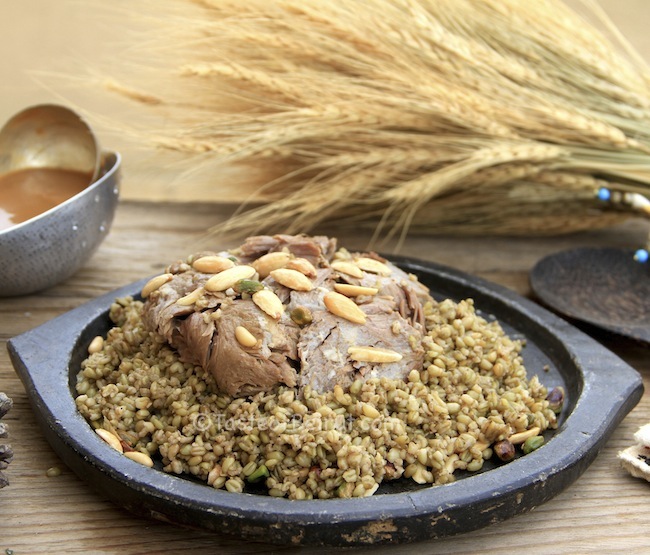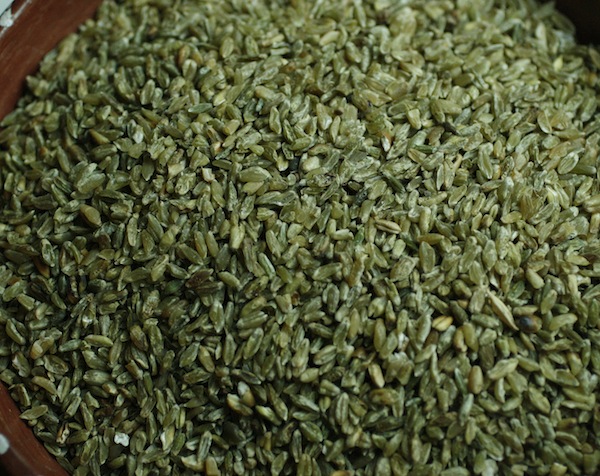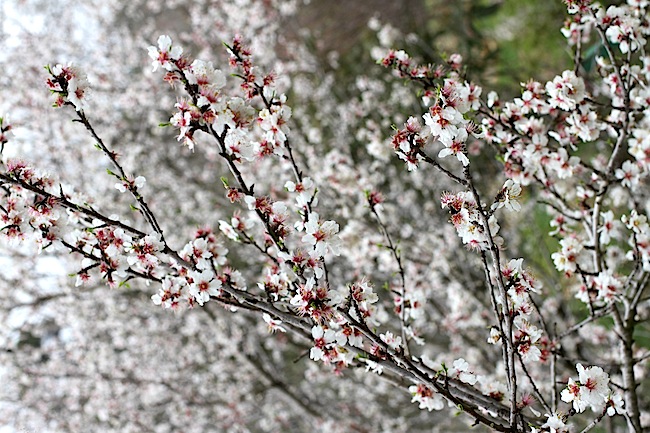Lamb shanks with roasted green wheat (Freekeh mufalfala)
February 17, 2013 • Category: Main Dish

A simple and hearty dish; you can use chicken or any other type of meat instead of the lamb shanks. The meat is browned then cooked in water and the resulting broth is used to cook the green wheat (aka freekeh). You can make this dish without meat since the freekeh is full of iron and minerals it is a fine substitute for meat anyway.
Freekeh is sold in Middle-Eastern stores, some health food stores and online. The quality varies so check the grains carefully; if they look broken up and full of debris, don’t get them; freekeh will have some black sediments because it is smoked wheat berries, but not all freekeh are equal.
INGREDIENTS: 4 servings
- 1 lb lamb shanks or beef stew meat
- 1 large onion, chopped
- 1 cup of freekeh
- 1/4 cup oil
- spices: salt, to taste, 1/2 tsp black pepper, cinnamon and allspice or seven-spice mix
- 1/2 cup of almonds, pine nuts and pistachios mixed (or one or the other, optional)
METHOD:
- Wash the freekeh under running tap water then soak for a few minutes.
- Heat the oil and fry the onion and meat till the meat is browned and the onion has softened. Sprinkle the spices on the meat, then cover with 5 cups of water and bring the mixture to a simmer; simmer the meat covered for 45 minutes over medium-low heat until the meat is cooked and falls off the bone.
- Remove the meat from the pot and set aside, discarding any bones or gelatinous bits. Take the broth and pour it through a sieve, pressing on the onion to extract as much onion pulp as possible. Drain the freekeh and heat a tablespoon of oil in the pot and fry the freekeh until all the grains are coated in oil. Pour the meat broth over the freekeh (you need double the volume of liquid to grain) and cover the pot; bring to a simmer and let it simmer gently for 30 minutes or longer if the grain is still hard. If needed, add a little water.
- Serve this dish with toasted nuts on top and the lamb pieces placed over the freekeh (previously reheated a bit).
NOTE: You can make a sauce with any extra broth; dilute 1 heaping tablespoon of cornstarch for each cup of broth in 1/4 cup of water. Heat the broth and when it starts steaming add the cornstarch mixture and stir for a couple of minutes until thickened. Taste, adjust seasoning and serve.
Even though it is February, cold and damp in the orchard trees are starting to grow their blossoms.
Comments
14 Comments • Comments Feed



Rosa says:
I wonder where I could finf green wheat here… This hearty and scrumptious dish must be amazing.
Cheers,
Rosa
On February 17, 2013 at 4:42 am
Belinda @zomppa says:
Beautiful dish! It looks hearty and healthy at the same time.
On February 17, 2013 at 5:27 am
Darya says:
Merci pour cette belle recette ! Je n’ai pas encore déniché de freekeh dans ma ville, mais il y a plein d’épiceries libanaises et maghrébines, alors j’espère en trouver, car j’ai mangé des plats délicieux en Syrie avec du freekeh, et ma liste de choses à essayer, comme ce plat, ne cesse de s’allonger !
On February 17, 2013 at 1:11 pm
Amy (runswithspatula says:
That looks beautiful and delicious! I have only used freekeh once to make the spicy freekeh meatball soup in the Jerusalem Cookbook. This recipe may be my second trial!
On February 17, 2013 at 6:33 pm
zerrin says:
Never heard of green wheat before! I wonder if I can find it here in Turkey. I love how it looks, I must search for it. Also, I love you make it with the broth, yummy! A wonderful dish for winter.
Love the shot of blossoms! I can almost feel the smell too! Trees have started to blossom here, too. Although they look so nice, I find it a bit terrifying at this time of year.
On February 20, 2013 at 3:36 am
Nadji says:
Toujours un plaisir de te rendre visite.
Il faut absolument que je visite ce Moyen-Orient qui me subjugue autant, à commencer par sa cuisine.
Ce jarret au frekkeh doit être un moment de pur plaisir gourmand.
A bientôt
On February 20, 2013 at 7:29 am
Oui, Chef says:
I keep reading more about Freekeh, I MUST get me some. The lamb looks meltingly tender…yum!
On February 20, 2013 at 4:40 pm
Jamie says:
Cooked, it kind of looks like farro… could be a replacement? But I adore lamb dishes and this looks divine!
On February 21, 2013 at 12:18 pm
domi says:
Quelle délicieuse recette !!! J’aime tout particulièrement l’agneau pour sa puissante saveur et sa texture si particulière ( fondante et filandreuse à souhait ). Quand au blé vert voilà encore un inconnu qui n’a pas été présenter à mes papilles. Gros bisous de France et passe une bonne semaine
On February 24, 2013 at 11:10 pm
Nuts about food says:
I still have never cooked with freekeh but the next time I come across a bag I will be sure to try it.
On March 6, 2013 at 4:44 am
anna says:
Hi, wondering if you can describe the taste and texture of the freekeh, I hear it’s nutty but not sure what to compare it to. I can’t eat it (gluten) but I’m trying to convert all my family’s lebanese recipes to be gluten free which involves finding substitutes. Any ideas for a wheat-free substitute?
On April 12, 2014 at 5:21 pm
Joumana says:
@anna: I would describe it as smoky and chewy and (delicious!). Can you use quinoa? that might be a good substitute minus the awesome flavor of the freekeh.
On April 13, 2014 at 4:23 am
Leslie Fakhoury says:
The Jordanian freekeh I’m used to has a strong scent that I actually like. My mom just brought me back some freekeh from Lebanon but it has no scent at all! Why is that? I haven’t cooked it yet though. Id appreciate your thoughts on this thanks!
On June 4, 2014 at 8:26 am
Joumana says:
@Leslie: Hi Leslie, try to find out first about the Jordanian freekeh, what type of wheat is it and is it local? A lot of wheat now processed in Lebanon comes from Saudi Arabia or other places. In fact, in Lebanon, some wheat is sold as “baladi” because most of the other wheat is imported! That may be the reason. Another reason could be that the freekeh you buy in Jordan is made by artisans. There are several factors: type of wheat, processing (artisan or industrial), shelf life, etc.
On June 5, 2014 at 2:40 am